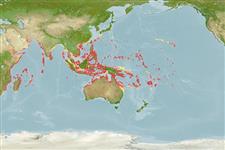Classification / Names
Common names from other countries
Main reference
Size / Weight / Age
Max length : 50.0 cm TL male/unsexed; (Ref. 2295); common length : 30.0 cm TL male/unsexed; (Ref. 30573); max. reported age: 15 years (Ref. 2293)
Length at first maturity
Lm 19.5 range ? - 21.1 cm
Environment
Marine; brackish; reef-associated; non-migratory; depth range 0 - 20 m (Ref. 9710)
Climate / Range
Tropical, preferred 28°C (Ref. 107945); 32°N - 32°S, 31°E - 155°W
Distribution
Short description
Dorsal
spines
(total): 10;
Dorsal
soft rays
(total): 9;
Anal
spines: 3;
Anal
soft rays: 8. Mouth slightly protractile; lips thick and fleshy. Inner base of pectorals densely covered with scales. Color is olive-green dorsally, paler ventrally; scales on back sometimes with white center. A large elliptical blotch, often broadly edged in yellow, on side directly below lateral line and centered at a vertical near the posterior tip of the pectoral fin. Sometimes light blue dots border the lower rime of the eye and around the nostrils. The pectoral, pelvic, dorsal and anal fins are white to pinkish. The caudal fin is orange or reddish. The vertical fins are sometimes lightly mottled or stripped.
IUCN Red List Status (Ref. 115185)
Threat to humans
Harmless
Human uses
Fisheries: commercial
More information
ReferencesAquacultureAquaculture profileStrainsGeneticsAllele frequenciesHeritabilityDiseasesProcessingMass conversion
Tools
Special reports
Download XML
Internet sources
Estimates of some properties based on models
Phylogenetic diversity index
PD50 = 0.5000 many relatives (e.g. carps) 0.5 - 2.0 few relatives (e.g. lungfishes)
Trophic Level
3.6 ±0.5 se; Based on diet studies.
Resilience
Medium, minimum population doubling time 1.4 - 4.4 years (K=0.45-0.49; tmax=15)
Vulnerability
Low to moderate vulnerability (29 of 100)
Price category
